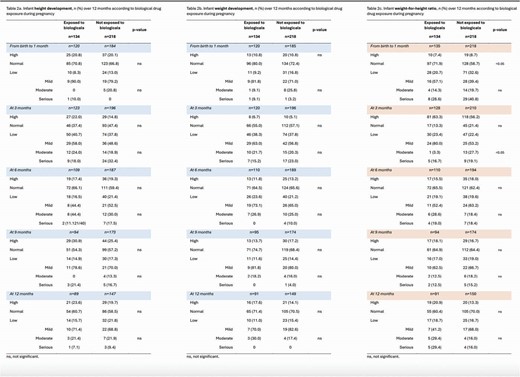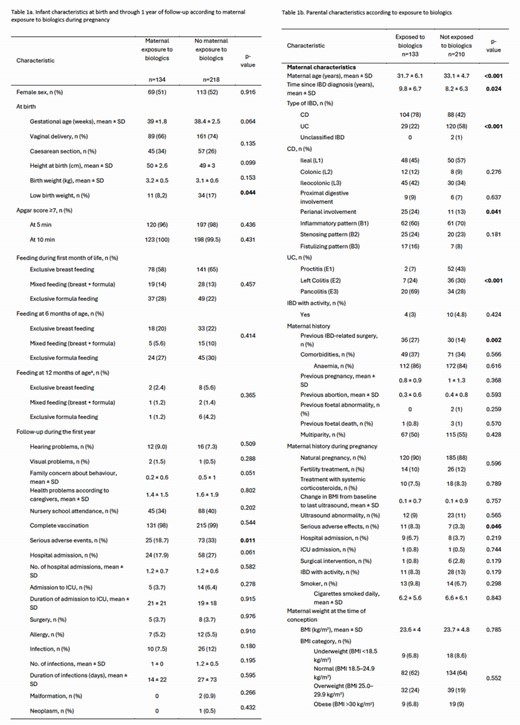-
PDF
- Split View
-
Views
-
Cite
Cite
L Palomino, M Velasco Rodríguez-Belvís, M J Casanova, E Leo-Carnerero, C Calviño Suarez, M Rivero, M Calvo, M T Arroyo, A Fernández-Clotet, I Pérez-Martínez, Á Masedo González, V Hernández, A Ruiz-Cerulla, P López Serrano, P Vega, I Rodríguez-Lago, R Vicente Lidón, M Á De Jorge, I Guerra, L Arias García, G Molina Arriero, D Hervías Cruz, D Busquets, A Gutiérrez Casbas, M Van Domselaar, G Valldosera Gomis, J M Vázquez Morón, M Piqueras Cano, A J Lucendo, M D Martín Arranz, P Ramírez de la Piscina, M D P Martínez Tirado, V Robles Alonso, S Marín Pedrosa, R Camargo Camero, E Cañedo Villaroya, R A Muñoz Codoceo, A García-Salido, J P Gisbert, M Chaparro, on behalf of DUMBO study group of GETECCU. *These authors share senior authorship, DOP038 Impact of prenatal and breastfeeding exposure to biologic drugs on the first-year anthropometric development of infants born to mothers with inflammatory bowel disease from DUMBO registry of GETECCU, Journal of Crohn's and Colitis, Volume 19, Issue Supplement_1, January 2025, Pages i152–i154, https://doi.org/10.1093/ecco-jcc/jjae190.0077
Close - Share Icon Share
Abstract
For children born to mothers with inflammatory bowel disease (IBD), the effects of maternal inflammation and exposure to biologic drugs during pregnancy may be significant. Elevated systemic inflammatory markers during pregnancy are linked to adverse birth outcomes and impaired infant growth. However, specific evaluation within the IBD context remains limited, and the impact of biologic drug exposure on early anthropometric outcomes is still uncertain. Aim: to analyze anthropometric development and malnutrition risk during the first year of life based on intrauterine and breastfeeding exposure to biologics in infants born to IBD mothers.
The study included mothers with IBD and infants from the DUMBO registry, a prospective registry started in 2019, involving 60 centers in Spain. Data of maternal status and treatments at conception, each trimester of gestation and postpartum, were included. Additionally, infants were assessed at birth, and at 3, 6, 9, and 12 months post-birth.
Infant development and nutritional status were assessed through ASPEN anthropometric criteria. Nutritional status was assessed by weight-for-height/length z-scores: ≤ -1.0 indicated malnutrition (mild: -1.0 to -1.9, moderate: -2.0 to -2.9, severe: ≤ -3.0). A z-score between -1.0 and +1.0 was considered adequate for sex and age (or corrected age in premature infants). Active IBD was defined as a partial Mayo score >2 in ulcerative colitis or unclassified IBD, and a CDAI >150 in Crohn’s disease.
A total of 352 children born to 343 women with IBD were studied. Among these, 134 infants (38%) were exposed to biologics during pregnancy, and 80 (23%) during pregnancy and lactation. No statistically significant differences were found in maternal characteristics, IBD activity during pregnancy, or child characteristics in the first year based on biologic exposure (Tables 1a, 1b). Infants exposed and non-exposed to biologics showed no differences in normal height and weight development during the first year of life (Tables 2a, 2b). Regarding the weight-for-height ratio, at 1 month of age, the proportion of infants with a malnutrition risk was significantly higher in non-exposed vs. exposed infants (33% vs. 21%, p<0.05). Similarly, non-exposed infants showed significantly higher prevalence of moderate to severe malnutrition at 3 months of age (47% vs. 20%; p<0.05) (Table 2c).
Our findings suggest that exposure to biologic therapies during pregnancy and breastfeeding is not only safe but may even have a beneficial effect on children's growth and weight development. This suggests that better control of maternal inflammation, beyond mere symptom relief, could positively impact child development.
1. Perichart-Perera O et al. Metabolic markers during pregnancy and their association with maternal and newborn weight status. PLoS One. 2017 Jul 27;12(7):e0180874. doi: 10.1371/journal.pone.0180874. PMID: 28749954; PMCID: PMC5531808.
2. Shafiq M, et al. Association of Maternal Inflammation During Pregnancy With Birth Outcomes and Infant Growth Among Women With or Without HIV in India. JAMA Netw Open. 2021 Dec 1;4(12):e2140584. doi: 10.1001/jamanetworkopen.2021.40584. PMID: 34935918; PMCID: PMC8696571.
3. Ross KM, et al. Pro-inflammatory immune cell gene expression during the third trimester of pregnancy is associated with shorter gestational length and lower birthweight. Am J Reprod Immunol. 2019 Dec;82(6):e13190. doi: 10.1111/aji.13190. Epub 2019 Oct 15. PMID: 31529581.
4. Mehta NM, Corkins MR, Lyman B, Malone A, Goday PS, Carney LN, Monczka JL, Plogsted SW, Schwenk WF; American Society for Parenteral and Enteral Nutrition Board of Directors. Defining pediatric malnutrition: a paradigm shift toward etiology-related definitions. JPEN J Parenter Enteral Nutr. 2013 Jul;37(4):460-81. doi: 10.1177/0148607113479972. Epub 2013 Mar 25. PMID: 23528324.


- pregnancy
- hiv
- inflammatory markers
- gene expression
- inflammation
- crohn's disease
- inflammatory bowel disease
- ulcerative colitis
- enteral nutrition
- biological products
- biological therapy
- birth weight
- breast feeding
- child
- child development
- malnutrition
- india
- infant
- newborn
- infant, premature
- lactation
- mothers
- pregnancy trimester, third
- postpartum period
- spain
- nutritional status
- prenatal care
- conception
- weight for height
- normal growth
- child malnutrition
- infant development
- causality
- intrauterine route of drug administration
- crohn's disease activity index
- birth outcome



